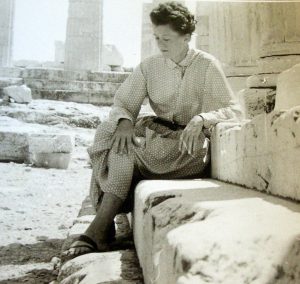 Peggy Glanville-Hicks won an international reputation as composer – more especially as an opera composer – and was the first, among the few women in this field to achieve such distinction.
Peggy Glanville-Hicks won an international reputation as composer – more especially as an opera composer – and was the first, among the few women in this field to achieve such distinction.
Born in Melbourne on December 29, 1912, her creative gift was manifest from early childhood, and at the age of fifteen she began lessons in composition with Fritz Hart.
In 1931 she won an open scholarship to the Royal College of Music in London, where for five years she studied with Vaughan Williams in composition, Arthur Benjamin for piano, and with Constant Lambert and later Sir Malcolm Sargent in conducting. In 1936, she was awarded the Octavia Travelling Scholarship for studies in Vienna with Egon Wellesz, and in Paris with Nadia Boulanger.
In 1938 Sir Adrian Boult conducted her Choral Suite in the I.S.C.M. Festival in London, the first time Australia had been represented in this Festival. In 1942 she moved her base of operations to America, and in 1948 again represented Australia in the I.S.C.M. Festival at Amsterdam, when the Concertgebouw Chamber Group performed her Concertino da Camera.Most of her works were written in America in the 1940s, 1950s, and 1960s, and most have been recorded, including two of the four operas.
Her name built steadily through the appearance of works such as the Three Gymnopedies, the Sinfonia da Pacifica, Letters from Morocco, Etruscan Concerto and Concerto Romantico. But it was The Transposed Heads, her opera with libretto by Thomas Mann, premiered in Louisville in 1954, and in New York in 1958, which securely established her unique status.
Following this premiere, the composer was commissioned to write a ballet score for the First Spoleto Festival – The Masque of the Wild Man choreographed by John Butler. She subsequently wrote several ballet scores for this renowned choreographer, which were produced in New York.
From 1950 to 1976, Glanville-Hicks made her home in Athens, from whence in 1959 -1960 a Fulbright Research Fellowship and a Rockefeller Grant made possible a comparative study of the Demotic music of Greece and the musical systems of India.
The outcome of these years was Nausicaa – an opera based on Greek Demotic musical materials, with libretto from the novel Homer’s Daughter by Robert Graves. The premiere, presented by the Greek Government in the Athens Festival of 1961, was a triumph, achieving international recognition and coverage. Following this success, the Ford Foundation commissioned a new opera for the San Francisco Opera House, and with Lawrence Durrell as librettist she wrote Sappho, again a work on a Greek subject.
For the Italian pianist Carlo Bussotti and American violist Walter Trampler she wrote her Etruscan Concerto and Concerto Romantico respectively, organising concerts where these premieres could create a concert debut for the young artists. The concerts in New York in 1956 and 1957 presented, also for the first time in the U.S.A., young Scandinavian composers, Vagn Holmboe and Karl Birger Blomdahl whose works were discovered by Glanville-Hicks while working on the Scandinavian Section of the new edition of Grove’s Dictionary. (Glanville-Hicks was also the author of all the American entries of the new Grove).
With Yehudi Menuhin she was co-M.C. for the concerts of Indian Music given at the Museum of Modern Art in 1955 and because of her extensive knowledge of oriental music she was in demand as consultant in the East-West musical affairs that touched the U.S.A.
From 1948 to 1958 Glanville-Hicks was one of the outstanding critics working on the New York Herald Tribune, and her reviews, as well as articles appearing in many other publications, displayed penetrating writing on contemporary musical topics.
From 1950 to 1960 she was also Director of the Composers’ Forum, organising an annual series of concerts in New York for young composers, many of which led to recordings. She was also responsible for the performance, publication and recording of works by a number of composers, particularly those who used, in some way, the modes and methods of the Oriental or Antique world.
In 1976, she returned to Australia and was a major figure in the national music scene until her death in June 1990. In her will she established a fund and residency for young Australian composers at her former home in the Sydney suburb of Paddington.
Biography from a 1969 brochure by BMI Music, New York. Edited by James Murdoch.
